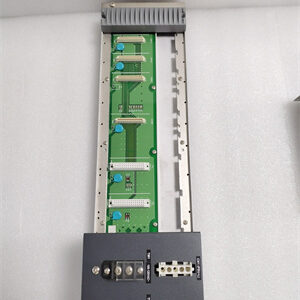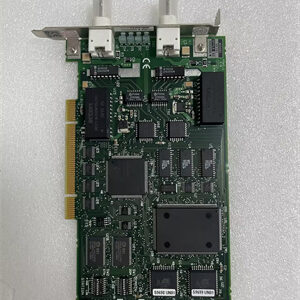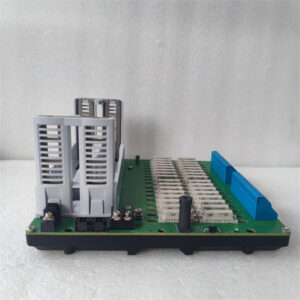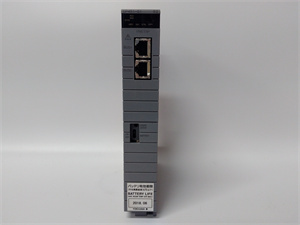Description
1. Detailed parameter table
| Parameter name | Parameter value |
| Product model | SC42-SP34 |
| Manufacturer | YOKOGAWA |
| Product category | Industrial Process Control Module |
| Control Loops | 4 independent PID control loops |
| Input Signals | 4-20mA DC, 0-10V DC (configurable per loop) |
| Output Signals | 4-20mA DC, relay contact (configurable per loop) |
| Sampling Rate | 100ms per loop |
| Accuracy | ±0.1% of full scale |
| Operating Temperature Range | -10°C to 60°C |
| Power Supply | 24V DC ±10% |
| Power Consumption | ≤8W |
| Dimensions | 45mm (W) x 120mm (H) x 180mm (D) |
| Weight | Approximately 0.6kg |
| Certification | IEC 61131-2, UL 508, CE, ATEX Zone 2 |
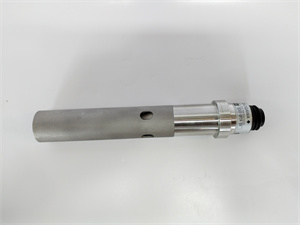
YOKOGAWA SC42-SP34
2. Product introduction
The YOKOGAWA SC42-SP34 is a compact industrial process control module designed to execute precise PID control in medium-scale automation systems. Unlike the analog input-focused SAI533-H33, this module integrates control logic execution with input/output capabilities, serving as a standalone control solution for processes requiring multiple independent control loops.
Equipped with 4 independent PID control loops, the SC42-SP34 can simultaneously regulate variables such as temperature, pressure, and flow in industrial processes. It accepts both 4-20mA DC and 0-10V DC input signals from sensors (compatible with those connected to the SAI533-H33) and provides configurable output signals to actuators like control valves and variable speed drives. With a sampling rate of 100ms per loop and ±0.1% accuracy, it ensures responsive and precise control, making it suitable for industries such as chemical processing, pharmaceutical manufacturing, and HVAC systems. As a versatile control component, the YOKOGAWA SC42-SP34 bridges the gap between data acquisition (from modules like SAI533-H33) and actuation (via modules like S2BN5D-121 DO), enabling closed-loop control to maintain process stability.
3. Core advantages and technical highlights
Multi-loop independent control:
Featuring 4 independent PID loops, the SC42-SP34 can manage separate processes simultaneously without cross-interference. In a pharmaceutical reactor system, it can independently control the temperature of the reactor jacket, pressure inside the vessel, agitator speed, and reagent flow rate—all through a single module. This eliminates the need for multiple single-loop controllers, simplifying system architecture and reducing communication latency between loops, which is critical for maintaining product quality in batch processes.
Flexible PID parameter tuning:
The module offers advanced PID tuning options, including auto-tuning, adaptive gain scheduling, and derivative filtering, allowing optimization for different process dynamics. In a batch fermentation process, its auto-tuning function can automatically adjust PID parameters as the culture grows and metabolic activity changes, preventing oscillations in dissolved oxygen levels. This adaptability ensures stable control even as process characteristics evolve, reducing the need for manual intervention by operators.
Seamless integration with data acquisition:
Designed to work with analog input modules like the SAI533-H33, the SC42-SP34 can directly access sensor data for control calculations. In a food pasteurization line, it receives temperature readings from the SAI533-H33 and immediately adjusts the heating element via its output, creating a closed-loop system with minimal latency. This tight integration ensures that control actions respond quickly to process changes, preventing deviations from setpoints that could affect product safety.
Compact design with rugged construction:
With dimensions of 45mm x 120mm x 180mm, the SC42-SP34 fits easily into control cabinets alongside the SAI533-H33 and PW482-10 S2 power supply. Its rugged design withstands vibration (10-2000Hz, 10g peak) and electrical noise, making it suitable for installation near motors and drives. In a metalworking facility, it maintains precise control of coolant flow rates despite the electromagnetic interference from welding equipment, ensuring consistent machining quality.
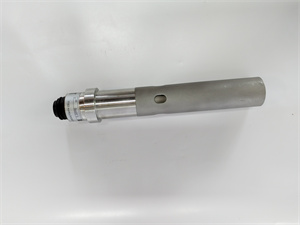
YOKOGAWA SC42-SP34
4. Typical application scenarios
In a chemical batch processing plant, the SC42-SP34 controls four stages of a reaction process: raw material preheating, mixing, reaction temperature, and product cooling. It receives temperature and pressure data from the SAI533-H33 module, executes PID calculations for each loop, and sends control signals to heating elements, valves, and pumps via the S2BN5D-121 DO module. The module’s auto-tuning feature adjusts parameters for each batch, ensuring consistent reaction yields even with variations in raw material composition.
In a commercial building’s HVAC system, the SC42-SP34 manages temperature and humidity in four separate zones. It processes data from temperature/humidity sensors (connected through SAI533-H33), controls damper positions and fan speeds via its outputs, and maintains setpoints based on occupancy schedules. Its adaptive PID tuning compensates for external weather changes, preventing overshoot in zone temperatures and reducing energy consumption by up to 15% compared to conventional controllers.
In a water treatment plant’s filtration system, the module regulates four critical processes: inlet flow rate, filter backwash timing, chemical dosing, and outlet turbidity. It uses pressure differential readings from SAI533-H33 to trigger backwashing when filters become clogged and adjusts chemical dosing based on flow rate, ensuring optimal water quality while minimizing chemical usage. The SC42-SP34’s independent loops prevent backwashing operations from disrupting the chemical dosing process, maintaining continuous water treatment.
5. Related model recommendations
- SC42-SP12: A 2-loop variant of the SC42-SP34for smaller systems requiring fewer control loops, offering the same tuning capabilities at a lower cost.
- SAI533-H33: The analog input module that provides process data to the SC42-SP34, enabling accurate measurement of variables for control calculations.
- S2BN5D-121 DO: The digital output module that works with the SC42-SP34to actuate devices like valves and pumps based on control signals.
- CP461-50: The PLC that can supervise multiple SC42-SP34modules in a distributed control system, coordinating overall process sequencing while the modules handle individual loop control.
- PW482-10 S2: The dual-input power supply that provides stable 24V DC to the SC42-SP34, ensuring reliable operation in fluctuating power environments.
- F3PU50-0N: The HMI panel that displays real-time loop data from the SC42-SP34, allowing operators to monitor setpoints, process variables, and adjust PID parameters manually if needed.
6. Installation, commissioning and maintenance instructions
Installation preparation
Before installing the SC42-SP34, ensure the mounting rail is securely fastened in a control cabinet with ambient temperature between -10°C and 60°C. Prepare tools including a torque screwdriver (0.5-1.5Nm), wire strippers, and a multimeter.
Verify the 24V DC power supply (from PW482-10 S2) is within the ±10% tolerance range and connect it to the module’s power terminals, ensuring correct polarity. Use shielded twisted-pair cables for input signals (from SAI533-H33) and output connections (to actuators), with shields grounded at both ends to minimize noise. Configure each loop’s input/output type via DIP switches or software before powering on, matching the connected sensors and actuators (e.g., 4-20mA for pressure transmitters, relay for contactors).
Maintenance suggestions
Perform quarterly visual inspections of the SC42-SP34 to check for loose connections, dust buildup, or corrosion on terminals. Clean the module’s surface with a dry cloth, avoiding contact with electrical components. Test auto-tuning functions semi-annually to ensure PID parameters remain optimized, especially after process modifications or sensor replacements.
Monitor loop status indicators: green LEDs indicate normal operation, while flashing LEDs signal loop alarms (e.g., setpoint deviation, sensor fault). Log alarm events weekly to identify recurring issues, such as frequent overshoot in a temperature loop, which may indicate the need for retuning or actuator maintenance. Check communication with supervisory systems (like CP461-50) monthly to ensure data integrity for trend analysis.
When replacing the SC42-SP34, backup the configuration file first and restore it to the new module to maintain identical loop settings. Store spare modules in anti-static packaging in a dry environment (10-60% RH) to prevent component degradation.
7. Service and guarantee commitment
YOKOGAWA provides a 5-year warranty for the SC42-SP34, ensuring reliability in critical control applications. Each module undergoes rigorous testing, including temperature cycling, vibration testing, and PID loop accuracy verification across a range of process conditions.
Our technical support team includes control system specialists with expertise in PID tuning and loop optimization, offering 24/7 assistance for commissioning and troubleshooting. On-site support is available in major industrial regions with a 48-hour response time, with priority service for pharmaceutical and chemical industry customers.
YOKOGAWA provides detailed application notes on PID tuning for specific processes (e.g., temperature control, flow control) and offers training programs on advanced control strategies using the SC42-SP34. Extended warranty options include annual calibration checks and software updates to ensure the module remains compatible with evolving system requirements, maximizing long-term performance in industrial control loops.
Full 12-month warranty on all components
Dedicated after-sales support
Same-day dispatch on 1000s of parts
All units are fully tested
- 1. Email confirmation
You will get an email confirming that we have received your enquiry. - 2. Dedicated Account Manager
One of our team will be in touch to confirm your part(s) specification and condition. - 3. Your quote
You will receive a comprehensive quote tailored to your specific needs.
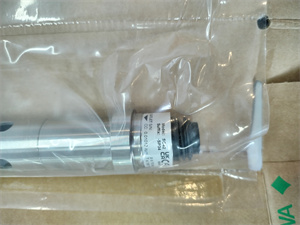
 Full 12-month warranty
Full 12-month warranty Available for dispatch immediately
Available for dispatch immediately We deliver worldwide
We deliver worldwide Full 12-month warranty on all components
Full 12-month warranty on all components